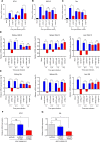Naturally occurring substitution in one amino acid in VHSV phosphoprotein enhances viral virulence in flounder
- PMID: 33465148
- PMCID: PMC7845975
- DOI: 10.1371/journal.ppat.1009213
Naturally occurring substitution in one amino acid in VHSV phosphoprotein enhances viral virulence in flounder
Abstract
Viral hemorrhagic septicemia virus (VHSV) is a rhabdovirus that causes high mortality in cultured flounder. Naturally occurring VHSV strains vary greatly in virulence. Until now, little has been known about genetic alterations that affect the virulence of VHSV in flounder. We recently reported the full-genome sequences of 18 VHSV strains. In this study, we determined the virulence of these 18 VHSV strains in flounder and then the assessed relationships between differences in the amino acid sequences of the 18 VHSV strains and their virulence to flounder. We identified one amino acid substitution in the phosphoprotein (P) (Pro55-to-Leu substitution in the P protein; PP55L) that is specific to highly virulent strains. This PP55L substitution was maintained stably after 30 cell passages. To investigate the effects of the PP55L substitution on VHSV virulence in flounder, we generated a recombinant VHSV carrying PP55L (rVHSV-P) from rVHSV carrying P55 in the P protein (rVHSV-wild). The rVHSV-P produced high level of viral RNA in cells and showed increased growth in cultured cells and virulence in flounder compared to the rVHSV-wild. In addition, rVHSV-P significantly inhibited the induction of the IFN1 gene in both cells and fish at 6 h post-infection. An RNA-seq analysis confirmed that rVHSV-P infection blocked the induction of several IFN-related genes in virus-infected cells at 6 h post-infection compared to rVHSV-wild. Ectopic expression of PP55L protein resulted in a decrease in IFN induction and an increase in viral RNA synthesis in rVHSV-wild-infected cells. Taken together, our results are the first to identify that the P55L substitution in the P protein enhances VHSV virulence in flounder. The data from this study add to the knowledge of VHSV virulence in flounder and could benefit VHSV surveillance efforts and the generation of a VHSV vaccine.
Conflict of interest statement
The authors have declared that no competing interests exist.
Figures







Similar articles
-
Generation of a recombinant viral hemorrhagic septicemia virus (VHSV) expressing olive flounder (Paralichthys olivaceus) interferon-γ and its effects on type I interferon response and virulence.Fish Shellfish Immunol. 2017 Sep;68:530-535. doi: 10.1016/j.fsi.2017.07.052. Epub 2017 Jul 27. Fish Shellfish Immunol. 2017. PMID: 28756289
-
Effect of G gene-deleted recombinant viral hemorrhagic septicemia virus (rVHSV-ΔG) on the replication of wild type VHSV in a fish cell line and in olive flounder (Paralichthys olivaceus).Fish Shellfish Immunol. 2016 Jul;54:598-601. doi: 10.1016/j.fsi.2016.05.014. Epub 2016 May 13. Fish Shellfish Immunol. 2016. PMID: 27184110
-
RNA-seq transcriptome analysis in flounder cells to compare innate immune responses to low- and high-virulence viral hemorrhagic septicemia virus.Arch Virol. 2021 Jan;166(1):191-206. doi: 10.1007/s00705-020-04871-5. Epub 2020 Nov 3. Arch Virol. 2021. PMID: 33145636
-
The Nucleoprotein and Phosphoprotein Are Major Determinants of the Virulence of Viral Hemorrhagic Septicemia Virus in Rainbow Trout.J Virol. 2019 Aug 28;93(18):e00382-19. doi: 10.1128/JVI.00382-19. Print 2019 Sep 15. J Virol. 2019. PMID: 31270224 Free PMC article.
-
Generation of Recombinant Viral Hemorrhagic Septicemia Virus (rVHSV) Expressing Two Foreign Proteins and Effect of Lengthened Viral Genome on Viral Growth and In Vivo Virulence.Mol Biotechnol. 2016 Apr;58(4):280-6. doi: 10.1007/s12033-016-9926-1. Mol Biotechnol. 2016. PMID: 26921191
Cited by
-
Applying genetic technologies to combat infectious diseases in aquaculture.Rev Aquac. 2023 Mar;15(2):491-535. doi: 10.1111/raq.12733. Epub 2022 Sep 5. Rev Aquac. 2023. PMID: 38504717 Free PMC article. Review.
-
Utilizing shRNA-expressing lentivectors for viral hemorrhagic septicemia virus suppression via NV gene targeting.Front Vet Sci. 2025 Apr 4;12:1508470. doi: 10.3389/fvets.2025.1508470. eCollection 2025. Front Vet Sci. 2025. PMID: 40256606 Free PMC article.
References
-
- Walker PJ, Benmansour A, Calisher CH, Dietzgen R, Fang RX, Jackson AO, et al. Family Rhabdoviridae In: van Regenmortel MHV, Fauquet CM, Bishop DHL, Carstens EB, et al. editors. The seventh report of the international committee for taxonomy of viruses. San Diego: Academic Press; 2000:563–583.
Publication types
MeSH terms
Substances
LinkOut - more resources
Full Text Sources
Other Literature Sources

